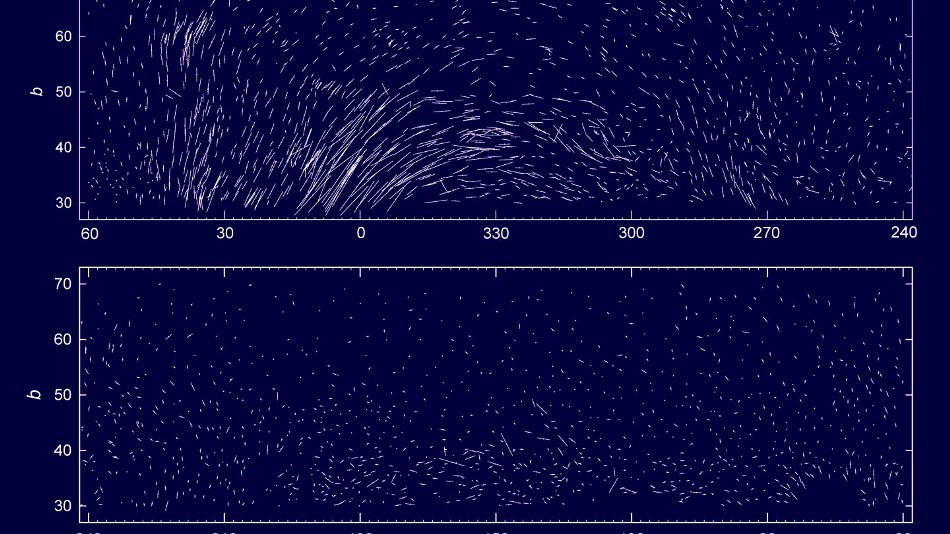Apr 9 2020
Headed by the Department of Physics and Astronomy at the University of Turku in Finland, an international research group has successfully mapped the interstellar matter distribution and interstellar magnetic field structure in the solar neighborhood.
 The structure of magnetic field and the distribution of dust in space is revealed by high-precision polarization measurements. The figure shows the degree and direction of polarization of more than 2000 stars in Galactic coordinates. The size of the dust particles responsible for polarization at the optical wavelengths is less than one micrometer, i.e., similar to solid particles in “smoke”. Image Credit: Vilppu Piirola.
The structure of magnetic field and the distribution of dust in space is revealed by high-precision polarization measurements. The figure shows the degree and direction of polarization of more than 2000 stars in Galactic coordinates. The size of the dust particles responsible for polarization at the optical wavelengths is less than one micrometer, i.e., similar to solid particles in “smoke”. Image Credit: Vilppu Piirola.
The study results were published in the leading European journal Astronomy & Astrophysics (A&A), in March 2020.
The magnetic field plays a vital role in the processes of planetary and stellar system formation. The research carried out under the guidance of Docent Vilppu Piirola and Docent Andrei Berdyugin is based on high-precision polarization measurements. The starlight that passes through interstellar clouds is polarized by the scattering of dust particles that are aligned by the magnetic field.
Polarisation means that electromagnetic oscillation is stronger in a specific direction that is perpendicular to the direction of motion of the light. The alignment of small, less than one micrometer in size, elongated dust particles is based on the same phenomenon as a compass needle aligning with the Earth's magnetic field, although it is a more complicated process.
Docent Vilppu Piirola, University of Turku
The study is specifically important because it is connected with the outcomes of the Interstellar Boundary EXplorer (IBEX) orbiter launched to investigate the Sun-magnetic field interactions in the solar neighborhood.
When interactions occur between the surrounding interstellar matter and the Sun and its magnetic field, the solar wind generates a so-called local bubble in which the density of matter is low and only a trace amount of dust is present.
The IBEX orbiter’s task is to watch the interface between the Sun’s heliosphere and the interstellar space and matter where the solar wind virtually ceases.
High-Precision Equipment Reveals Magnetic Field Direction
By tracking the energetic neutral atoms (for example, neutral hydrogen) that travel via the heliospheric boundary, the IBEX orbiter receives data of the interstellar magnetic field (ISMF).
However, the ISMF direction can be determined precisely only through polarization measurements. For these kinds of measurements, high-precision equipment—that has polarization detection sensitivity at the level of or better than 0.001% (one part in hundred thousand)—has been designed at the Tuorla Observatory of the University of Turku.
The observations reported in the new study were performed using four telescopes: one in La Palma (Nordic Optical Telescope), two in Hawaii (Haleakala and Mauna Kea observatories), and one in the southern hemisphere at the Greenhill Observatory of the University of Tasmania.
The observations have revealed interesting magnetic filament structures both in the direction where our solar system is moving in relation to the surrounding interstellar space (heliosphere ‘nose’) and in the opposite direction (heliosphere ‘tail’). The filaments form ribbon-like arcs where dust particles and starlight polarisation have aligned with the direction of the magnetic field.
Docent Vilppu Piirola, University of Turku